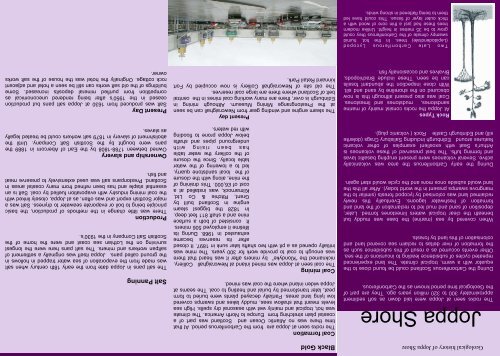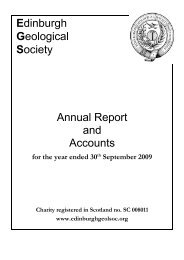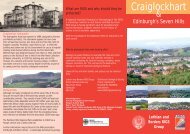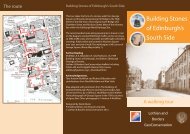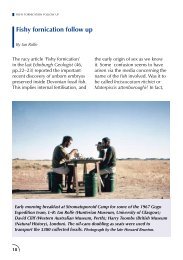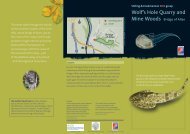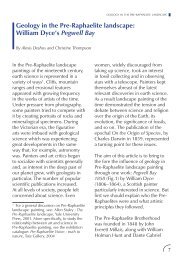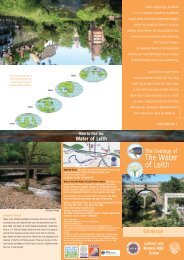A4 pdf version - Edinburgh Geological Society
A4 pdf version - Edinburgh Geological Society
A4 pdf version - Edinburgh Geological Society
Create successful ePaper yourself
Turn your PDF publications into a flip-book with our unique Google optimized e-Paper software.
<strong>Geological</strong> history of Joppa Shore<br />
Joppa Shore<br />
The rocks seen at Joppa were laid down as soft sediment<br />
approximately 300 to 320 million years ago. They are part of<br />
the <strong>Geological</strong> time period known as the Carboniferous.<br />
During the Carboniferous Scotland could be found close to the<br />
equator with a warm, tropical climate. The land experienced<br />
repeated cycles of subsidence leading to incursions of the sea.<br />
Other events occurred as a result of this subsidence such as<br />
the formation of river deltas to reclaim sea covered land and<br />
colonisation of this land by forests.<br />
When covered by sea (marine) the base was muddy but<br />
beneath the clear tropical waters limestones formed. Later,<br />
deposition of sand and mud led to reclamation of the land and<br />
formation of freshwater lagoons. Eventually this newly<br />
reclaimed land was colonised by lycopod forests (similar to the<br />
mangrove swamps present in the world today). After all this the<br />
land would subside once more and the cycle would start again.<br />
During the early Carboniferous the area was volcanically<br />
active. Several volcanoes were present erupting basaltic lavas<br />
and forming tuffs. The best preserved of these volcanoes is<br />
Arthur’s Seat with excellent examples of other volcanic<br />
features around <strong>Edinburgh</strong> including Salisbury Crags (dolerite<br />
sill) and <strong>Edinburgh</strong> Castle Rock ( volcanic plug).<br />
Rock Types<br />
At Joppa the rocks consist mainly of marine<br />
sandstones, mudstones and limestones.<br />
Coal was also present although this is now<br />
obscured on the shoreline by sand and silt.<br />
With close inspection the abundant fossils<br />
can be seen. These include Brachiopods,<br />
Bivalves and occasionally fish.<br />
Black Gold<br />
Coal formation<br />
The rocks seen at Joppa are from the Carboniferous period. At that<br />
time there was no Atlantic Ocean and Scotland was part of a<br />
coastal plain stretching from Europe to North America. The climate<br />
was hot, tropical and mainly wet with seasonal dry spells. High sea<br />
levels meant that shallow seas, muddy lakes and swamps covered<br />
low lying land areas. Partially decayed plants were buried to form<br />
peat, later transformed by burial and heating to coal. The seams at<br />
Joppa widen inland where the coal was mined.<br />
Coal mining<br />
The coal seen at Joppa was mined inland at Newcraighall Colliery,<br />
nicknamed the “Klondyke” by miners after it was heard that there<br />
was enough to coal to provide work for 300 years. The mine was<br />
initially opened as a pit with two shafts later sunk in 1897. It closed<br />
after its reserves became<br />
exhausted in 1968. During its<br />
lifetime it employed 506 miners.<br />
It consisted of both a surface<br />
mine and a shaft 811 feet deep.<br />
In 1828 the biggest steam<br />
engine in Scotland built by<br />
Grant, Ritchie & Co Ltd,<br />
Kilmarnock, was installed at a<br />
cost of £6,000. This draining of<br />
the mine, along with the closure<br />
of the local sandstone quarry,<br />
led to a lowering of the water<br />
table locally. Since the closure<br />
of the colliery the water table<br />
has been rising with<br />
underground pipes and shafts<br />
below Joppa prone to flooding<br />
with red waters.<br />
Present day<br />
The steam engine and winding gear from Newcraighall can be seen<br />
at the Prestongrange Mining Museum. Although mining in<br />
<strong>Edinburgh</strong> is over, there are many working coal mines in the central<br />
belt of Scotland where there are large coal reserves.<br />
The old site of Newcraighall Colliery is now occupied by Fort<br />
kinnaird Retail Park.<br />
Salt Panning<br />
The salt pans in Joppa date from the early 18th century when salt<br />
was made from the evaporation of sea water trapped in hollows in<br />
the ground called pans. Joppa itself was originally a settlement of<br />
saltpan workers and miners. The salt pans here were the longest<br />
surviving on the Lothian sea coast and were the home of the<br />
Scottish Salt Company in the 1930’s.<br />
Production<br />
There was little change in the methods of production, the basic<br />
principle being to boil or evaporate seawater to dryness. Salt was a<br />
major Scottish export and was often, as at Joppa, closely linked with<br />
the coal mining industry with evaporation fuelled by coal. Salt is an<br />
essential staple and has been refined from many coastal areas in<br />
Scotland. Prestonpans salt was used extensively to preserve meat<br />
and fish.<br />
Ownership and slavery<br />
Owned between 1788-1808 by the Earl of Abercorn in 1889 the<br />
pans were bought by the Scottish Salt Company. Until the<br />
abolishment of slavery in 1879 salt workers could be treated legally<br />
as slaves.<br />
Present Day<br />
Salt was produced from 1630 at Joppa salt pans but production<br />
ceased in the 1950’s after being rendered uneconomical as<br />
competition from purified mineral deposits increased. Some<br />
buildings of the old salt works can still be seen a hotel and adjacent<br />
rock cottage. Originally the hotel was the house of the salt works<br />
owner.<br />
Two Late Carboniferous Lycopod<br />
(Lepidodendrale) trees. In the hot, humid<br />
swampy climate of the Carboniferous they could<br />
grow to be 35 metres in height. Unlike modern<br />
trees these had just a thin core of wood with a<br />
thick outer layer of tissue. This could have led<br />
them to being flattened in strong winds.


